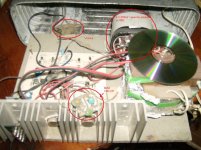Hi Red,
Can you share the program PCB layout please. Im new here and i want to build a project also.
Can you share the program PCB layout please. Im new here and i want to build a project also.
The software I am using it is called Eagle.
http://www.cadsoft.de/cgi-bin/downl...download.htm.en&dir=eagle/userfiles/libraries
Hope it helps...
http://www.cadsoft.de/cgi-bin/downl...download.htm.en&dir=eagle/userfiles/libraries
Hope it helps...
Hello again guys.
Finally after a long time I had a few moments to work at my amplifier and I already have a problem.
The pnp transistor draws 50mA more current from the supply than the npn one.
more explicit I have set a Iq of 100 mA through the MJ15022 by measuring the voltage on the R32 of 20 mV (change the value of the resistor to 0.22 Ohms) and on the other one R33 I have 30 mV...
I have no ideea where to search for the problem...
Thanks
Finally after a long time I had a few moments to work at my amplifier and I already have a problem.
The pnp transistor draws 50mA more current from the supply than the npn one.
more explicit I have set a Iq of 100 mA through the MJ15022 by measuring the voltage on the R32 of 20 mV (change the value of the resistor to 0.22 Ohms) and on the other one R33 I have 30 mV...
I have no ideea where to search for the problem...
Thanks
Hi Red,
when checking the quiescent conditions the input should have a shorting plug inserted and the output should have no load connected.
Then the output offset voltage can be measured and if necessary adjusted.
If DC output offset exists AND a load is connected then some current will flow from the output stage into the load. This could be the current difference you have measured.
The low frequency output noise can also be measured checking for excessive hum.
when checking the quiescent conditions the input should have a shorting plug inserted and the output should have no load connected.
Then the output offset voltage can be measured and if necessary adjusted.
If DC output offset exists AND a load is connected then some current will flow from the output stage into the load. This could be the current difference you have measured.
The low frequency output noise can also be measured checking for excessive hum.
wow,
I think something is really wrong... I removed the load and measured up the offset (shorted the input to the gnd )... I have about 200 mV DC on the output of the amp. When I have measured the AC Voltage of the output with an multimeter is showed 9 volts AC... 🙁(
But when i used a speaker I heard nothing... I believe I have an oscillation but i don't own an oscilloscope so I can't be sure...though sounds pretty good on music it heats up the heatsink.
The quiscent is the same... 81mA on the NPN power transistor and 118 mA PNP...(no load)
Any ideas?
I think something is really wrong... I removed the load and measured up the offset (shorted the input to the gnd )... I have about 200 mV DC on the output of the amp. When I have measured the AC Voltage of the output with an multimeter is showed 9 volts AC... 🙁(
But when i used a speaker I heard nothing... I believe I have an oscillation but i don't own an oscilloscope so I can't be sure...though sounds pretty good on music it heats up the heatsink.
The quiscent is the same... 81mA on the NPN power transistor and 118 mA PNP...(no load)
Any ideas?
- Status
- Not open for further replies.
- Home
- Amplifiers
- Solid State
- Help Modifying an amplifier schematic
